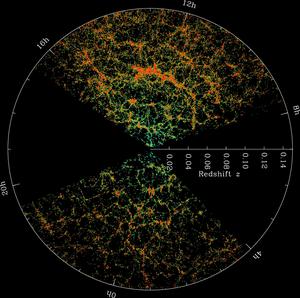Glossarbegriffe: Rotverschiebung
Description: Der Begriff "Rotverschiebung" kann sich auf drei verschiedene Effekte beziehen: auf den Doppler-Effekt, die kosmologische Rotverschiebung oder auf gravitative Rotverschiebung.
Die Doppler-Rotverschiebung ist das Gegenteil der Blauverschiebung. Bei der Rotverschiebung entfernt sich die elektromagnetische Strahlungsquelle vom Beobachter, sodass die Wellenlänge der elektromagnetischen Strahlung zu längeren (röteren) Wellenlängen gestreckt wird. Das ist vergleichbar mit dem Doppler-Effekt bei Schallwellen.
Die kosmologische Rotverschiebung ergibt sich aufgrund der physikalischen Ausdehnung des Raums (Universums), den Strahlung durchquert: Die Wellenlänge der Strahlung wird größer, d.h. zu längeren (röteren) Wellenlängen gestreckt. Damit unterscheidet sich die kosmologische Rotverschiebung von der Doppler-Rotverschiebung, die auf die relative Bewegung zwischen Strahlungsquelle und Beobachter zurückzuführen ist.
Die gravitative Rotverschiebung bezieht sich auf den Effekt, dass die Wellenlänge der von einer Quelle ausgesandten elektromagnetischen Strahlung zu längeren Wellenlängen gestreckt wird bzw. die zugehörigen Photonen Energie verlieren, wenn sie versuchen, eine Region (Gravitationsquelle) zu verlassen, in der die Schwerkraft stärker ist.
Zugehörige Glossarbegriffe:
See this term in other languages
Term and definition status: The original definition of this term in English have been approved by a research astronomer and a teacher The translation of this term and its definition is still awaiting approval
The OAE Multilingual Glossary is a project of the IAU Office of Astronomy for Education (OAE) in collaboration with the IAU Office of Astronomy Outreach (OAO). The terms and definitions were chosen, written and reviewed by a collective effort from the OAE, the OAE Centers and Nodes, the OAE National Astronomy Education Coordinators (NAECs) and other volunteers. You can find a full list of credits here. All glossary terms and their definitions are released under a Creative Commons CC BY-4.0 license and should be credited to "IAU OAE".
If you notice a factual or translation error in this glossary term or definition then please get in touch.
Zugehörige Medien
SDSS Redshift Map
Bildnachweis: M. Blanton and Sloan Digital Sky Survey credit link
License: CC-BY-4.0 Creative Commons Namensnennung 4.0 International (CC BY 4.0) icons









